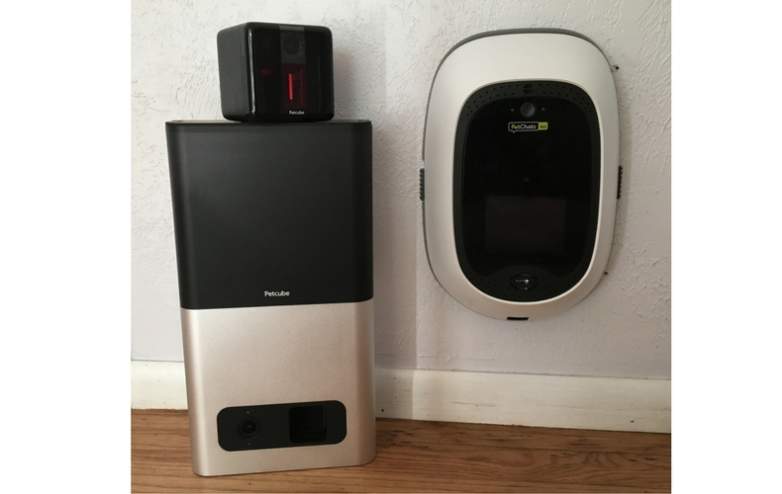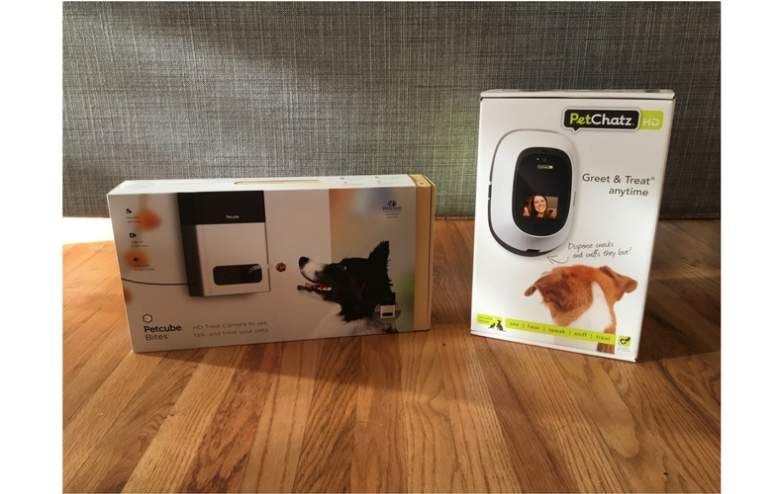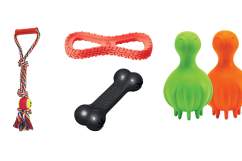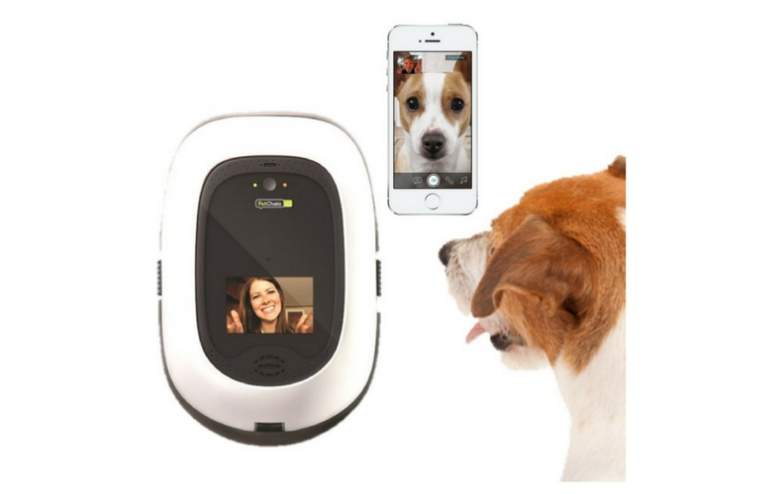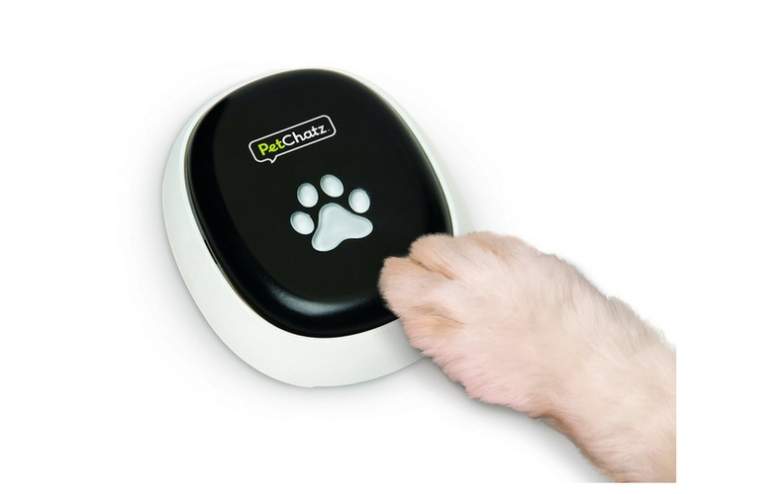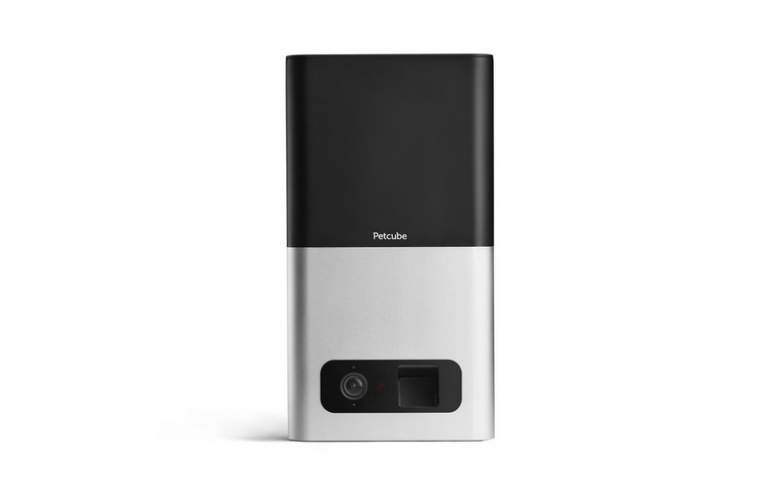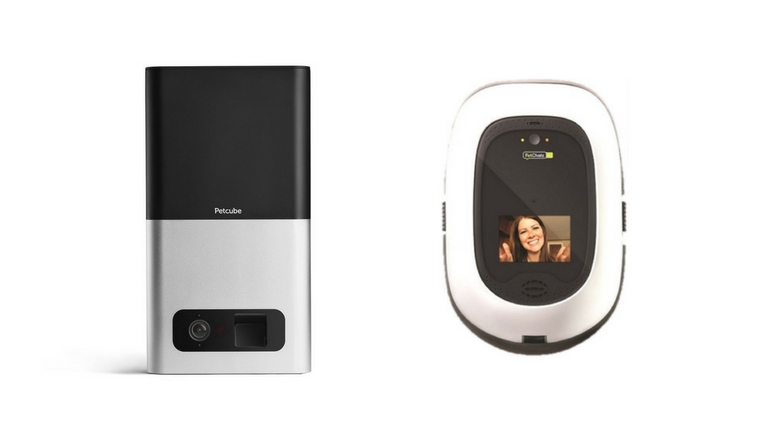
To some degree, being a pet owner means constantly balancing your time at work, the gym, socializing, and a million other things with making time for your pets. Most of our lives require leaving the house, often for extended periods, which can sometimes mean spending less time with your dog or cat than you’d like. Occasionally, this can lead to destructive behaviors or separation anxiety.
You could treat the anxiety with medication specifically meant for dogs. That will work sometimes. Getting them proper exercise and stimulation by playing with them when you can is great, too. Many dog owners crate train, which is another key strategy. But there’s something else you can do, too.
Technology has advanced sufficiently that a wide variety of pet cameras are now available on the market. We previously discussed ten great options here for wifi-enabled cameras that allow you to check in on your animals when you’re not around. Most have 720 or 1080p cameras, two-way audio, and some sort of recording capability. Increasingly, makers of these cameras are adding another feature — app-enabled treat dispensing.
This differs from automatic pet feeders in that these treat-dispensing cameras aren’t meant to replace mealtime. Rather, they can be used to train your dog to understand that your leaving isn’t a cue to panic or destroy the furniture. Having the house to themselves can be fun and quite literally rewarding. There are a few of these cameras on the market, most of them covered in those ten options we discussed previously. Among the best of them are the PetChatz HD and the Petcube Bites.
While we discussed the PetChatz and Petcube Play in detail here, the Bites is new to the market. It’s due to be released on Amazon on October 2, 2017. After spending some time with both units, we compare them below to help with your buying decision.
Trying to decide between a PetChatz HD and a Petcube Bites? Here are ten points of comparison to help you choose.
1. Petcube Bites vs. PetChatz HD: Look & Feel
Right away, it’s evident which of these two units was designed to integrate seamlessly into a modern, connected home. The Petcube features a slick design and high quality materials that are pleasant to the touch. The treat hopper (more on that in a minute) is made of soft touch plastic and the lid is fastened with sturdy clips. The rest of the unit is made of aluminum akin to that on an Apple computer. At 2 ¾ inches thick, it’s a streamlined unit that fits pretty much anywhere. It’s rather tall at 13 inches, but on the whole, it’s a very handsome unit.
By contrast, the PetChatz looks exactly like what it is: something made for pets. The thin white plastic is on the cheap side and something about the screen on the front really cheapens the look. Of course, that little screen is a major differentiator to the Petcube, and we’ll get to that shortly. It sticks out over four inches from the wall and tapers from the ten inch base. You won’t want to put this thing very many places, but as you’ll see in the next section, that isn’t even an option.
Advantage: Petcube Bites
2. Petcube Bites vs. PetChatz HD: Installation
In my first review of the PetChatz, I outlined the major drawback to this unit: it must be installed over an outlet. Here are the points I included in that review about the installation:
1. There’s no pass through slot in the base that would allow you to plug something else into the outlet. That means giving up two outlets to power one unit.
2. The USB wall wart meant to be hidden inside the base of the unit is quite large, which made installation a bit challenging. The instructions say to mount the PetChatz flush with the top left corner of the outlet, though I found that it wouldn’t work until I moved it about half an inch to the left. I strongly suggest measuring several times before drilling because I’m fairly certain you will get this wrong the first time.
3. You’ll have to shut the power to that outlet off at the circuit breaker lest you drill through the wire in the wall powering the outlet. This seems unnecessarily dangerous. If your wires are installed correctly, you realistically should have no trouble. I just don’t really get the appeal of firing screws in around outlets.
4. If the faceplate on the outlet is too large, you’ll have to change it to a smaller one or the unit won’t sit flush against the wall.
The goal of tall his seems to be to hide the cord so pets won’t be tempted to mess with it. After using the Petcube, having the cord showing doesn’t bother me (or my dogs) at all. To be fair, PetChatz does offer a custom stand for times when the outlet isn’t the best place for it, but to my eye, it makes an already aesthetically-challenged unit a little bit worse.
Another minor drawback of the PetChatz is that to turn on or off the camera or refill the treats, you need to remove the thin plastic cover of the unit. The buttons are solid enough, but I have my doubts that the cover itself will stand the test of time. Be very gentle and you might be just fine.
As for connecting to wifi, the screen does indeed make it easy, displaying the status and giving you better cues than the Petcube’s colored LED system. It only took one try to get it connected to the internet, whereas both the Bites and the Play from Petcube took a couple of tries (more on this in the Connectivity section below).
The relatively minor wifi quibbles is where the disadvantages of installing the Petcube stop, however. Installation of the Bites is far, far easier. The key difference is that Petcube have made no attempts to hide the cord, which is a generous ten feet and connects simply to the side of the unit. Sure, it takes points away from the overall look just a bit, but it makes everything about owning one easier when compared with the PetChatz. They even include a handy mounting guide so you don’t have to measure.
Both units included the screws and drywall anchors necessary for mounting. Unless you’re really picky about the cord showing, this is no contest at all — the Petcube wins here.
Advantage: Petcube Bites
3. Petcube Bites vs. PetChatz HD: Camera

Amazon
The team at PetChatz have put “HD” right in the name of the product, but you really have to hunt around to find the resolution. It’s 1280 by 720, or the colloquial 720p. The viewing angle is 65.5 degrees with a motion detection range of 54 degrees. It is a low-light camera and performance is solid.
Since the PetChatz is mounted at outlet height, which will be about a foot off the floor in most cases, this necessarily limits the viewing area. On my husky mix, it’s aimed at the bottom of his chest. On my smaller pit mix, I can see his face until he’s right up on it. If you can get your medium-to-large dog to lay down using the two-way audio, they should be perfectly in shot, while small dogs and cats should be in frame most of the time.
The Petcube’s camera is full 1080p HD with a viewing and motion detection angle of 138 degrees. The low light performance is pretty good, but on the whole, I actually found the light balance to be better on the PetChatz. I mounted the Petcube higher on the wall, giving me a rather commanding view of almost my entire house. The Petcube takes it if you’re looking purely for the most coverage.
The key differentiator here might be that the PetChatz is two-way video, as well as two-way audio. Using your front-facing phone camera, your dog can actually see you while you’re talking. Unfortunately for me, none of my three dogs are much for screens, rendering this key feature somewhat irrelevant. Still, that’s the reason the PetChatz takes the less-sleek form factor that it does, so if your dog responds to the screen, it’s a pretty big upgrade.
Advantage: Tie — Petcube has the specs, but PetChatz offers two-way video and better light balance
4. Petcube Bites vs. PetChatz HD: Audio
Both units allow for two-way audio. Background noise on the Petcube is pretty bad, however. It’s basically a microphone hooked up to your whole home, with your outgoing audio echoing back to you. At times, it’s pretty difficult to tell what sounds are coming and which are going. The lag is also considerable, occasionally delaying the sound for upwards of two seconds.
Within the app settings of the Petcube, you can trigger it to send a push notification whenever it detects a “significant level of noise”. This will clue you in to when your dog is barking so you can either calm them or figure out what’s going on at the house.
The audio on the PetChatz is fantastic. The noise reduction is stellar and you can get pretty subtle when speaking into it. I can clearly whisper to my dogs and they still come running. In my testing, the lag was virtually non-existent, especially in comparison to the Petcube. Overall, a far better experience. You mileage may vary, but PetChatz figured out the audio portion as far as I can tell.
Advantage: PetChatz HD
5. Petcube Bites vs. PetChatz HD: Connectivity

Amazon
The Petcube requires that your wireless router use WPA/WPA2 encryption and will not work when using WEP. It also requires a 2.4 gHz signal, which is pretty standard. Setup relies on a smartphone with Bluetooth to identify the unit, select your wireless network, and enter the password.
I encountered an error that said information could not be written to the Petcube. If this happens, plug it into your computer, wait for the light to turn white or start blinking, then use the reset pin to press the reset button quickly three times. This will initiate a test that will play a voice prompt, check the treat dispenser, and cycle through the LED colors. You should be able to enter your network details and have them save after that.
Actually, this was the second error I encountered with the Petcube. The first unit I tested needed to be sent back because it failed to update the firmware. If, after your first use, the LED turns orange and appears to be offline according to the app, leave it alone for at least 30 minutes. This means that the firmware is updating and unplugging it or disconnecting the internet while this is happening could cause a fault. I suspect that I had a network disruption while it was updating, which caused the files to corrupt. Petcube’s customer service was extremely prompt and helpful, determining within two emailed responses what had happened and sending out a new unit (with return label for the bricked one) within two days. If you should have any problems with your Petcube at all, you’re in good hands.
The PetChatz HD will work with the weaker WEP encryption, and is also supported by WPS Protected Setup. Indeed, I used the WPS button to set it up the first time and it worked like a charm. A manual web interface connection option is outlined in the PetChatz manual, if you should need it. That part was a breeze.
Weirdly, however, whenever the PetChatz is connected to my wireless network, odd things start to happen. Other devices will get kicked off or the connection speed will slow, even when there’s no call going on. It’s unfair to blame this squarely on the camera without further investigation into other causes, but I can tell you it doesn’t happen with the Petcube or any other device for that matter.
Both units use SSL encrypted connections, but given the state of tech and the threat that the Internet of Things implies, I think you might be better off with the Petcube’s more stringent security requirements. You can opt to use the PetChatz with WPA/WPA2, though, and you should. After initial setup, the Petcube is quicker to reconnect when powered on subsequently. Ultimately, they’re both easy enough to use on a daily basis and stay connected as long as they’re on. I can’t condemn the PetChatz for the network weirdness until I troubleshoot everything else going on in my house, so we’ll call this a draw.
Advantage: Tie
6. Petcube Bites vs. PetChatz HD: App
Both apps are just plain fun to use. Petcube’s app is probably a little bit more what you’d expect from a modern design standpoint, but certainly neither are getting in your way as you try to play with your pet from afar. Both of them allow for multiple cameras to be connected to your app, so if you have one in each room, switching between them is a breeze.
The Petcube’s main screen displays the various cameras you might have at the top, along with a calendar and timeline of your past recordings. The status of the camera is clearly displayed, as is the status of Care, Petcube’s mode for automatic recording. If Care is Awake, it will detect motion, begin recording, and send a push notification. Quiet detects and records, but skips the notification, and Sleep disables it entirely. Believe me, unless you really need it, the notifications get annoying, so better to put Care to sleep. From the main screen, you can also manage the Sharing Settings so you can add friends, family members, and even the general public to your camera’s stream.
The call screen works in landscape orientation, with controls for recording, camera still, treats, and Facebook Live (yikes — not for me; I will never use this) clearly visible. Two-way audio is hidden beneath the gear at the top right of the screen. Note: Don’t test it while you’re sitting right next to the Petcube or you’ll trigger a pretty wicked feedback loop because of the delay.
The treat dispenser is fun in that it doesn’t just drop, but rather flings it according to how far you drag up on the treat image. My dogs probably don’t love that I can fling it over their heads, but they can’t help but come up close to investigate when they hear the treat being loaded out of the hopper. The Bites lacks the Play’s laser function, so anything more interactive is kind of out on this model.
The main screen of the PetChatz app is a solid wall of lime green, with your named camera button as the star attraction. When you click your camera, it starts the feed. You can initiate a two-way video call by clicking the chat bubble on the right or record a 30-second video with the button below it.
When you initiate a call, a jingle plays. My dogs figured out what this song means about the second time, as once you click it, the treats button is revealed. There’s no throwing option here; it just drops out of the bottom. You can also play the jingle again with another button to get their attention. A small screen in the upper right hand corner shows what is displayed on the front screen of the unit, which will likely be your face. One slightly irritating glitch is that once you hang up from your call, the app is extremely reluctant to switch back to portrait mode. Not a huge deal, but it bugged me.
In the menu of the PetChatz app, you can also hook up your DogTV subscription, which will then play on the screen to entertain your pups.
Tough to call a winner here. They’re both intuitive apps that make it easy to interact with your pet when you’re out of the house. The Petcube app is a bit more modern and lets you control virtually every aspect of your account, so I’ve given it the slight edge.
Advantage: Petcube Bites
7. Petcube Bites vs. PetChatz HD: Treats
Both units come with treats out of the box, which is pretty handy. That’s about where the similarities end.
On the PetChatz, you’re provided a plastic tube that serves as the hopper inside the unit. It’s plenty easy to fill and install, so there’s no problem there. Cleaning it could be a tiny bit fussy, but that’s no big deal. The downside here is that they really, really want you to use their treats, which apparently must be bought on the company website.
Inside the PetChatz manual it says, “PetChatz Treatz have a unique shape and size and are made with a proprietary recipe specifically designed for use in the PetChatz system. Using any other treat may clog the system or cause other damage (and void the One Year Limited Warranty).” That makes sense, I suppose; if you want to be sure you’re covered in the event of an issue, follow their instructions to the letter.
But here’s the weird part: The manual also says, “Over time treats can start to bridge together and get stuck in the treat cup. We recommend that you gently shake treat cup once each day.” It’s odd to me to use a proprietary formula that would experience this kind of issue. If you know it’s a possibility, why not come up with a formula that doesn’t do this? I’ve already noted my concern that the plastic faceplate is on the flimsy side, so I’d like to avoid taking it off as much as possible. Removing it once a day to unstick the treats made specifically for this unit doesn’t work for me.
Additionally, the proprietary shape of these treats appears to be roughly the same volume as the Pet Botanics treats we included on our best training treats post, just a bit taller and narrower. To me, this is more about capturing ongoing revenue than the function of the machine, which could easily have been made to accommodate fairly standard treat sizes.
I appreciate that PetChatz need to make money, so I don’t really begrudge them this. However, it’s hard to even compare when the Petcube Bites will allow you to use virtually any treat you want. Pictured above is a page from the manual that serves as a guide for what treats to use for optimal performance. My tester unit came with two bags of Wellness treats: Kittles for cats and Petite Treats for dogs.
If you opt to use something else, they must be dry, hard treats measuring between 0.3 and one inch in length. They should be all the same size and shape so the distributor inside doesn’t get snarled, but that’s not a difficult ask at all. If what you decide to use is available via Amazon, you can set up an automatic Dash replenishment from within the app so you never run out. Super convenient, if you’re into that kind of thing.
The treat hopper is also superior. The entire top of the unit comprises the hopper and can be removed for easy cleaning. You only need to take off the very top lid to refill it. Simpler and better, in my opinion. Puzzlingly, the Petcube manual says the hopper can hold 100 treats, but that is way underselling it. The two treat packs they send have 150 as it is (although they are small) and this only fills the hopper a third of the way and maybe less. The PetChatz holds 100 treats and that seems much more accurate to me. In either case, a low/no treat indicator will display in the app when supplies dwindle. When refilling, you’ll have to reset the low treat indicator on the PetChatz, but the Petcube figures it out on its own.
The PetChatz will almost always dispense exactly one treat, while the Petcube can dispense as many as four, depending on the size. (My dogs thought this was the best part.) Either way, they last quite a long while, and I couldn’t get them to jam even rapidly dispensing as often as the app would let me. The PetChatz is more prone to misfires, but they were infrequent and negligible.
For the superior hopper and the freedom of choosing your own treats, point goes to the Petcube.
Advantage: Petcube Bites
8. Petcube Bites vs. PetChatz HD: Other Features
Both units offer motion and sound detection connected to push alerts. On the Petcube, this is tied to the Care service, which is detailed in the next section. That pretty much covers it for the extra features of the Petcube.
The PetChatz on the other hand offers the two-way video, a slot for a scent release pad, and a Game Mode. For an additional $99.99, you can add the PawCall, which allows your pet to call you and offers further interactivity, including treat rewards for playing along with the game. For an additional $59.99, you can buy a guard to further protect the unit from damage. These extra costs add up, but they do extend the functionality in a way unavailable to the Petcube.
Advantage: PetChatz HD
9. Petcube Bites vs. PetChatz HD: Pricing
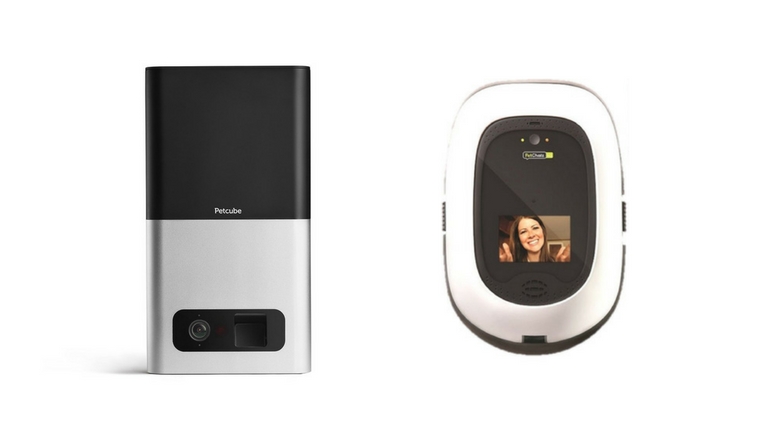
Author photo
The Bites sells for $249, while the PetChatz rings in at $379. That’s a pretty big gap, especially considering that at the end of the day, the specs of the Petcube are strictly better.
That additional $130 for the PetChatz buys you four things: 1. Two-way video, 2. Scent pad, 3. The ability to use PawCall, 4. The ability to stream DogTV. But since the PawCall isn’t included and adds an additional $100 to the price, we’ll leave that out from this particular consideration. Besides, with the motion detection of the Petcube, you could very nearly create a similar effect, anyway. It’s basically down to the two-way video out of the box. In my experience, it’s nowhere near worth the money, since my dogs learned quickly to look for treats and ignore the screen altogether.
That being said, part of the reason for the higher price is that the PetChatz is made in the U.S. and the Petcube is made in China. For the most part, this isn’t much of a consideration when pricing this kind of tech, but it goes some way to explaining the gap.
As for subscriptions, PetChatz does not appear to have one. You can record as many 30-second video clips as you want, as far as I can determine. Adding DogTV to your current Comcast or DirecTV contract costs $4.99 or $9.99 a month, and two free months are included with your purchase.
For the Petcube, a 30-day trial of the Petcube Care service is included, which gives you a ten day history of automatically-recorded video triggered by movement. After the 30-day trial, you get four hours of cloud video storage for free. Subscription levels after the trial are as follows:
- 10-day video history: $10/month or $100/year
- 30-day video history: $30/month or $300/year
Like the treats, scent pads, and scents of the PetChatz, it’s pretty clear that Petcube’s model is meant to capture ongoing revenue from the Care service. It’s relatively inexpensive, though, and with this recorded history, the unit could feasibly double as a home security camera in the event that the motion or noise detection captures something significant.
At the end of the day, shelling out almost $500 for the full shebang on the PetChatz might be a tough pill to swallow.
Advantage: Petcube Bites (unless you want your hardware made in the U.S.A., which only the PetChatz HD can provide)
10. Petcube Bites vs. PetChatz HD: Conclusion
After considering all these points and living with the units awhile, my vote is firmly for the Petcube. The ease and flexibility of installation alone nearly sealed the deal, but the far better design and ability to choose my own treats provided the finishing touches.
For my purposes, the additional features of the PetChatz didn’t add up to the extra cost. While I do strongly prefer things made in the U.S. whenever possible, the added cost of ownership, reduced flexibility for both placement and treats, difficult installation, and sub-par aesthetics were all knocks against the unit.
That said, if you need those extra things and can make use of them, I can absolutely see why you might opt for the PetChatz. It’s a very good unit with a lot of functionality. Just because my dogs don’t care about anything on the screen doesn’t mean this will be true for yours. Dogs with separation anxiety may be able to make good use of it.
What might have served as the foil for the Petcube turned out to be a selling point. Though I do find them somewhat finicky to connect to wifi the first time, and certainly the firmware bricking situation was not a point in its favor, I was glad for an opportunity to evaluate the customer service. Especially given that Petcube’s model seeks ongoing payment in the form of the Care service, you want to be sure that you can get a hold of a knowledgeable professional in case of an incident. (To be fair, I had no occasion to contact PetChatz support, but I’m sure they are lovely and competent, as well.)
Our choice: Petcube Bites
